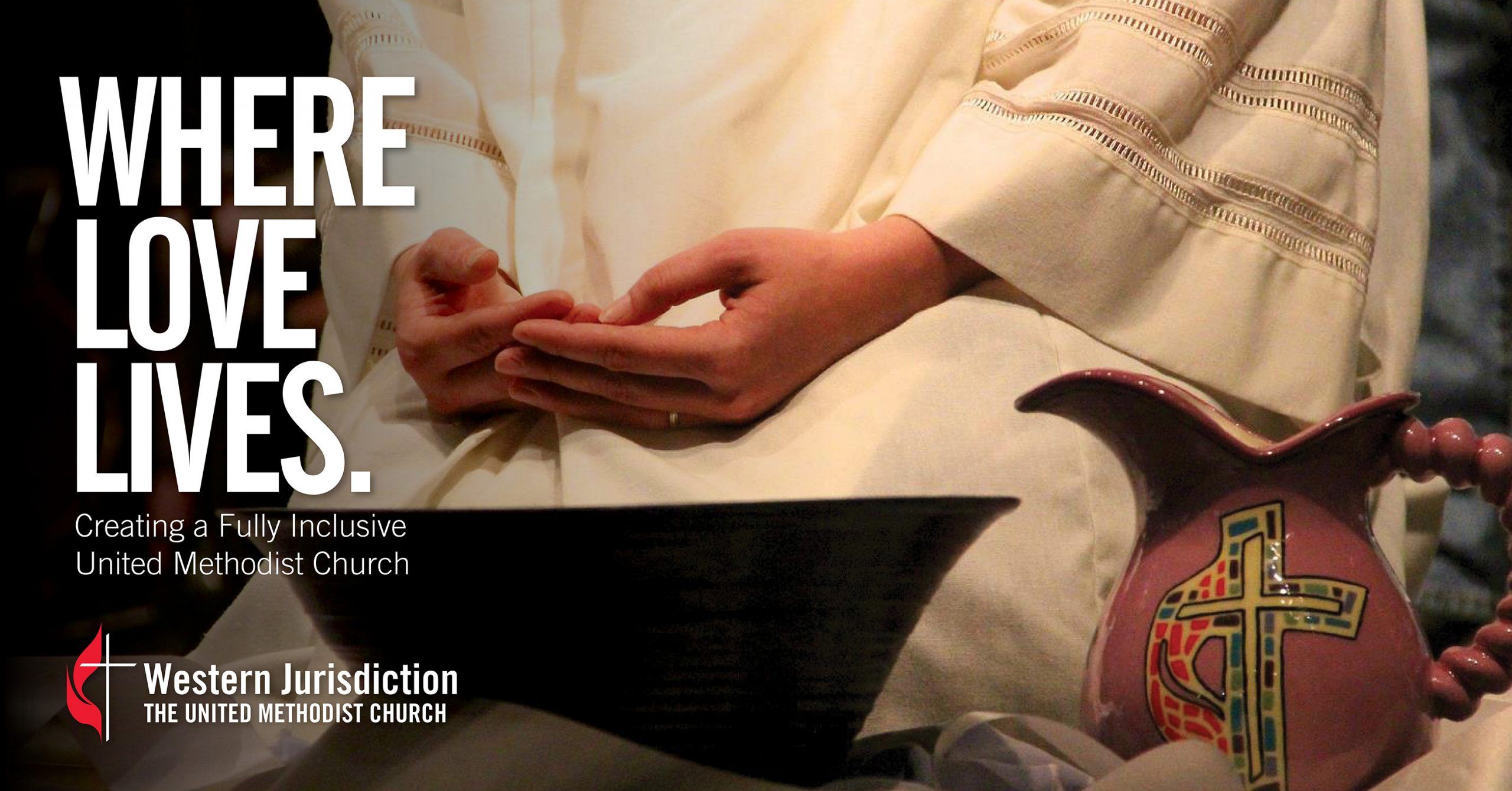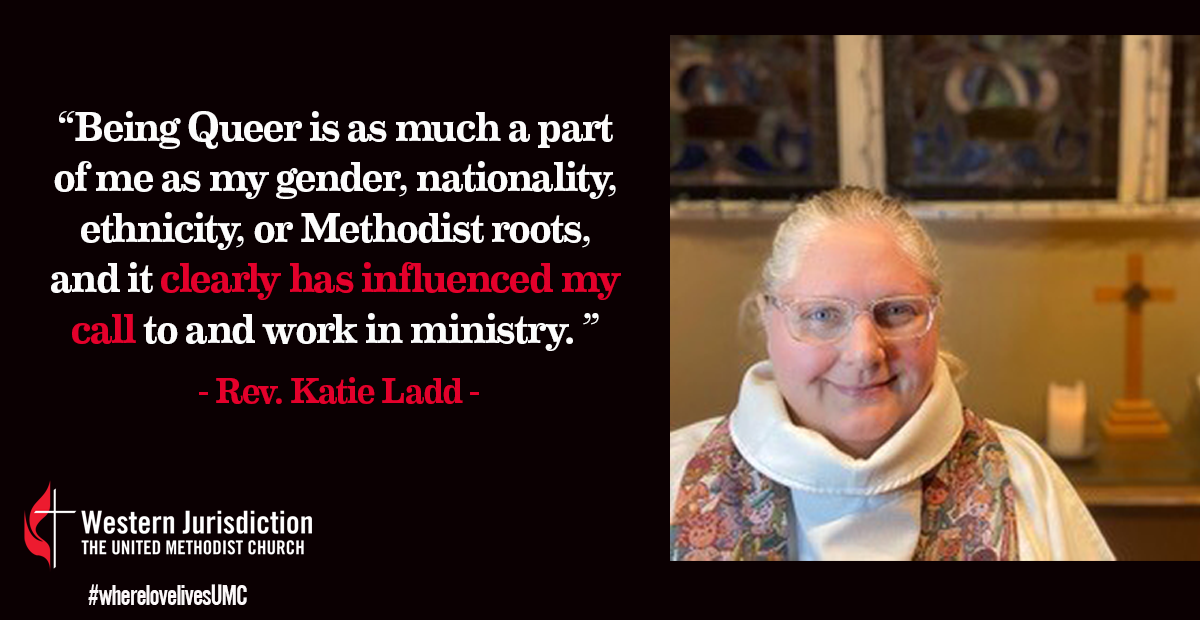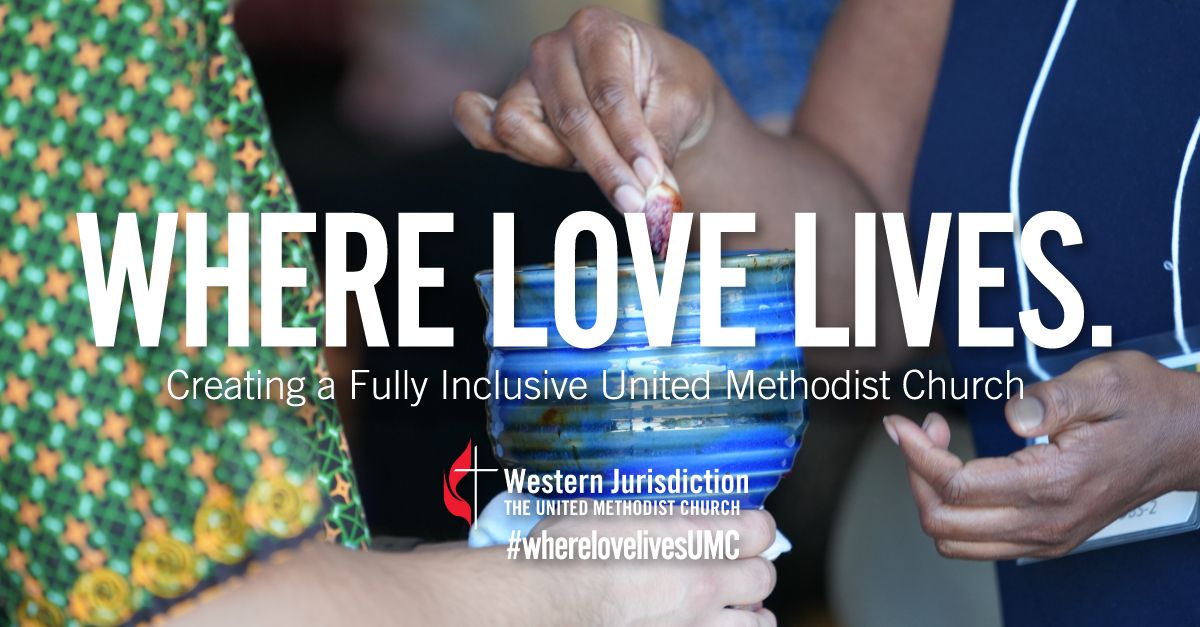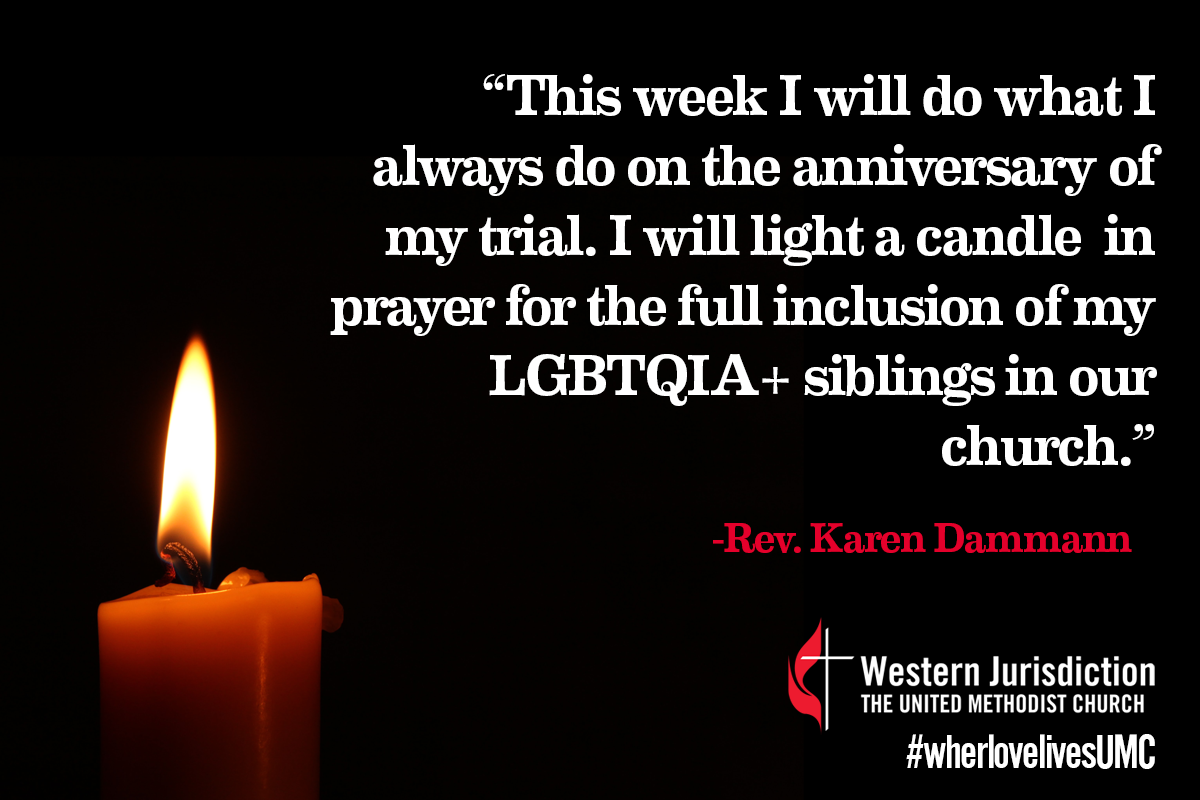Fair and equal ordination for all: A queer clergyperson’s path to ministry, ordination and hope for full inclusion
As the Western Jurisdiction of The United Methodist Church continues its “Where Love Lives” campaign this month, the Greater Northwest Area of The UMC will explore our LGBTQ+ siblings’ call to ministry in a denomination where, by and large, they are still not welcome.
This is the unfiltered story of Rev. Katie Ladd, an ordained elder in the Pacific Northwest Conference who identifies herself as queer. Listen to her story of being called to ministry as an outsider, going through her ordination service without her beloved standing beside her, and her hopes for the denomination’s future.
Being Methodist is a core part of my personal identity. My family counts two circuit riders in it – Jeptha Hughes and Ashley Hewitt. While history does not indicate calling, the stories of circuit riding down the Natchez Trace and into Louisiana fueled my imagination as a child. I preached to my stuffed animals on the Sundays we did not go to church. This imagination would become part of my dreaming for a church rooted in the past, oriented to the context in which it is found, and nimble and responsive to a future yet to be charted.
The first real voice that invited me to think about ordained ministry was my associate pastor, a woman, who approached me after youth Sunday and remarked that I might give the idea some thought. I brushed it off with a laugh. After my first year in college (a United Methodist liberal arts college), I began the candidacy process; it languished for years. While working for an environmental chemistry firm in Houston, my spirit cried out for more. My college advisor from the religion department encouraged me to return to graduate school with eyes toward a master’s degree of divinity (MDiv). I wanted to enroll in a master’s degree in art program en route to a doctorate degree. This adviser persuaded me against the latter, seeing in me something I couldn’t see in myself. This has been true throughout my call.
Some are called from deep within; some of us have the call articulated by others and are guided toward a life that we otherwise would not have chosen – think Jonah or Moses. Even in divinity school, I did not see myself working in a church setting. Medical ethics was my focus. Yet, throughout a gradual but transformative time, the work of sowing community and participating in the healing of the world through community led me back to what my ancestors did so long ago – pastoral work in a rapidly changing social landscape.
Being Queer is as much a part of me as my gender, nationality, ethnicity, or Methodist roots, and it clearly has influenced my call to and work in ministry. Throughout my life, I have been an outsider. I have never fit in. Some of that is due to sexual orientation, but not all. This outsider status has opened me to empathy in a way that transcends the particularities of my own experience and in ways that bring me into deep spiritual community with people very unlike me. That said, when I began the long and circuitous route to ordination, sexual orientation was not part of the conscious discernment process – not until divinity school. It was there that the dean of Methodist studies discouraged me from taking Methodist classes. He deemed them a “waste of time” because I refused to live in a closet. I insisted on living out as God created me to be. Therefore, I would either never be ordained or would not remain ordained. He told me to save my money and spend it elsewhere in school.
In the 1990s there was no place for an out bisexual clergy person in any denomination, including ours. While I didn’t take his classes, that discouragement achieved the opposite of his goals; it made me more determined than ever to stake my claim in the church that had been my home – and my family’s home – for generations. I belonged here and no prejudice would drive me out. Most of my early ministry was centered on people living with addiction, as I have done. I worked with abused and neglected children. I worked with unhoused youth and young adults. While I have never experienced this kind of trauma, I did know what it felt like not to belong and to know what it means to have one’s core self-excluded, ignored, derided, and despised.
But the privilege of growing up loved and secure gave me a strength to stand in the breach with those not afforded the same. Knowing a God who always embraced me in times of duress put holy ground under my feet. I understood the experience of exile and the joy of homecoming. These have circumscribed my ministry – exile and homecoming. This is fueled by the slights and struggles I experienced as a young Queer person, but my ministry is with and to all who have experienced exile and who yearn for sacred homecoming.
My ordination process began in what was once called the North Arkansas Annual Conference. I grew up around Memphis, TN, just south in Mississippi and just north in Arkansas. My family is from the Arkansas, Mississippi, Louisiana corner of our nation. I’m deeply Southern. It won’t surprise anyone that neither my theology nor my person found home in the church that formed me. The church that baptized me ultimately did not want me to serve any of its congregations. My process was largely unremarkable until I went before the Board of Ordained Ministry where things went decidedly and horribly wrong. Evidently my psychological evaluation was returned with a handwritten note that said that I “don’t conform to traditional female roles,” which was, evidently, code for suspicion that I might be “gay.” Not wanting to deal with this in a direct manner in the mid-90s, another tack was taken – to tear apart answers to theological questions. At first the conversation with the board was confusing, then heated, and eventually it turned acrimonious. During a break, the same pastor who had first approached me regarding ministry filled me on the assumptions. I simply challenged them to ask if I was gay and I left. That ended the process in Arkansas. Much like being dissuaded from taking Methodist classes in divinity school, this did not stop the pursuit of ministry. Rather, I searched for a place where my exile could become homecoming. That led to the Pacific Northwest Conference. One might think the challenges ended here.
While my time here has been much different from Arkansas, there were challenges in my process and there remain challenges in ministry. Leading up to annual conference where I was to be ordained an elder, I was cautioned not to bring my partner up with me during the laying on of hands as is the tradition. I couldn’t in good conscience leave my spouse sitting with my church and bring my parents. I was ordained alone. That is a more dramatic moment, but life is filled with such moments. For years, or so I’ve been told, there were people who asked for me not to receive an appointment. That exile experience made its way into my heart, too. For years I needed a new robe or alb, but I wouldn’t buy one because I was certain that I wouldn’t make it through the next year as a pastor of a church. I have lived with that for 23 years of ordained ministry. That low level anxiety continues to be part of me even though I am unaware of it most of the time: I still don’t have business cards….
Even here in the PNW Conference, and the Western Jurisdiction, we have work to do today.
Even in congregations that become part of the Reconciling Ministries Network movement, much work is needed to re-sculpt them into places of homecoming for LGBTQIA+ people, including clergy. Beyond that, even in those congregations that have created strong ecosystems of welcome for and leadership from LGBTQIA+ people, much is needed to align this work for justice and dream for homecoming with other struggles, such as dismantling white supremacy.
Struggles do not exist in a vacuum. Injustice does not exist in a silo. Each is related to the other. As part of our Gospel call, there is much to do, and it cannot, or should not, be left to individual clergy and congregations to sort out alone. For example, I was going to be appointed to a congregation that was not yet reconciling. In conversation with the then bishop about my concerns, I was told that no preparation would be done because sexual orientation shouldn’t be an issue. There was a distinct “if we don’t talk about it, it’s not a problem” naïveté with this attitude. This kind of naiveté creates harm, and, as Wesleyans, our first rule is to “do no harm.” Harm ensued. Over the years there have been acts of vandalism, protests, and even threats of violence directed toward the churches I’ve served and to me. Largely I have been left to sort through these on my own using pre-existing relationships to seek wisdom and to my own devices to find the resources required. This is not connectionism at work. We can, and must, do better.
As we look to what Methodism might be in the future, I hope that our new incarnation will not simply be the same old church but one that will fully embrace LGBTQIA+ people. I hope we let the Holy Spirit blow through this institution with holy life that ties us each to another – struggle to struggle, hope to hope, congregation to congregation such that no person feels abandonment, despair, injustice or oppression. The Gospel is a proclamation of life in the midst of death. To affirm Queer folks is to break open the staid and dead systems that hold us down so that life erupts in unexpected ways. This requires truth telling, life sharing, discomfort, and hard and courageous conversations – absolutely about sexual orientation and gender identity, but also about so much more – sexual ethics, white supremacy, wealth and money, missional priorities, colonialism, prophetic nerve, bold action, empowered laity, willingness to fail, nimble systems, accountability for the privileged, and courageous leadership.
God is at work in our world and in our people. The prophets tell us that God calls from the margins and demands that we center the widow, the orphan, and the stranger – those who are most despised and vulnerable. The community that does this is on the side of God’s Gospel of life. We need to center the voices of those who have been pushed aside, dismissed, and discounted. Then we will find ourselves moving toward the beloved community – God’s holy reign.
Standing in solidarity against anti-Asian hate
Friends in ministry in the Greater Northwest Episcopal Area,
Where does love live, if not in our hearts and in our relationships with God and our neighbors?
My heart is heavy with this week’s news of a young white man’s racial hatred targeting Asian and Asian American women for murder in Atlanta. Is there no limit to the depths of hatred and inhumanity?
What insanity blames innocent fellow citizens for a virus that spreads silently, putting people of every nation and race at risk? No-one is safe. No-one is to blame. If one suffers, we all suffer together.
My heart overflows with love for the women who lost their lives, for elders attacked on sidewalks, for passers-by spit at. Love lives where people lay their lives down for their neighbors, not where people violate the dignity, safety and very lives of their neighbors out of irrational fear and hatred.
Listen with me to the reflections of my friend and colleague, Bishop Bob Hoshibata of the Desert Southwest Conference, who said this week: “We must confront the ways that harm presents itself: whether it be ‘innocent’ re-telling of jokes, to perpetuating racist rhetoric related to COVID-19, or violent actions to innocent people, we must acknowledge that these are things that fuel bias and prejudice against those of Asian heritage.”
I affirm the words from Asian and Asian American Bishops of the United Methodist Church, the New Federation of Asian American United Methodists, the Asian American Language Ministry Plan, along with other Asian American leaders and academics of the United Methodist Church, including some from the Greater NW Area: “We ask that all United Methodists read again and live out our own Charter for Racial Justice which states that all persons are of equal value in the sight of God and that racism is a rejection of the teachings of Jesus Christ.”
I encourage you to participate in this webinar, March 24 at 4 p.m. PDT, hosted by Asian-American friends and colleagues in the California-Nevada Conference.
May the LOVE of God continue to light our path in these dark days,

Bishop Elaine JW Stanovsky
“Let your Life Speak” A laity voice for Fair & Equal Ordination for All
Fair and equal ordination for all: “Was it worth it?” Recalling the trauma from going on trial as an LGBTQ+ clergy
As we continue our “Where Love Lives: Fair and Equal Ordination for All” storytelling project as part of the Western Jurisdiction campaign for a fully inclusive church, we hear from Rev. Karen Dammann, who this week 17 years ago was put on trial for “practices incompatible with Christian teaching” three years after disclosing to then-Pacific Northwest Conference Bishop Elias Galvan that she was a lesbian.
Her trial drew national media attention to a Sunday school classroom at Bothell UMC. She was acquitted by a 13-member board of her peers. But as you’ll read in her first-person account, Dammann still wonders if the scrutiny, the fear, the isolation and more were all worth it.
It was 17 years ago this week that my family and a team of supporters arrived at a church north of Seattle for the trial that was to determine whether I was guilty of “practices incompatible with Christian teaching”.
This trial came at the end of a three-year legal process that began in 2001 when I came out to my Bishop. Our child was two-and-a-half years old at that time and had just started to call me “Mama.” This normally exciting development was the point that required me to face the fact that the closet was no place to raise a child. We would not teach this innocent being – our child – to lie, and we could not expect our child to keep his family a secret.
I thought about surrendering my credentials when we decided to leave the closet, but the person who had become our pastor, Rev. John Auer, asked me if I was still called to the ministry. The answer was “yes.” With John’s support, and the help of his congregation, I was able to come out to my Bishop.
I knew there would be consequences for my choice, the main one being the loss of my vocation. We hoped that coming out of the closet, rather than quietly quitting, might help our denomination move toward full inclusion of LGBTQ+ persons. What we were not prepared for was the media scrutiny, estrangement from colleagues, and threats to our safety.
The Rev. Bob Ward and our legal team built a defense that included a broad slate of church experts who offered to testify for full inclusion in our denominational polity. For three days, we heard testimony that shined a light on our denomination’s unjust exclusive stance. This testimony made possible a “not guilty” verdict.
Bishop William Boyd Grove, presiding bishop, ended the trial by sealing the trial record, which effectively ended the possibility of sharing the expert testimony with the rest of the denomination.
In the years since I have asked several times to have the transcript released, not just for the Church, but for our child, who was the catalyst for being us being truthful about who his family is.
In 2018 I met Stephen Drachler (formerly of UM Communications, now a consultant) at a Reconciling Ministry Gathering. We spoke about the trial and he offered to approach Bishop Grove about releasing the transcript.
As a result of Stephen’s action, I received a letter from Bishop Grove in January of 2019 telling me that he and Bishop Elaine JW Stanovsky had agreed to release the transcript to me and to the public. (Thank you, Stephen!) Thank you also to Bishop Grove on behalf of the two-and-a-half year old, the 5-year-old and the now 22-year-old person I had hoped would have the transcript to read one day.
Last February (2020) Bishop Elaine told me the transcript had not been found in the PNW Office, even though, according to the provisions of the Book of Discipline, the transcript and all records of a trial shall be held in a special secure file by the Secretary of the Annual Conference.
That brings us to the present moment. I have been asked if it was worth it.
In many ways it was not worth it. When the transcript and the information that it contained was sealed, the hope that the cost of my coming out would help our denomination to see a way to include everyone slipped away. The danger and threats that our family experienced was never worth it. Sadly, our denomination continues to officially exclude from full participation LBGTQIA+ people. We are now in limbo waiting for the church to split over the issue. What difference did it make after all?
On the other hand, was it worth it? In some ways it was. The Greater Northwest has become a place of full inclusion for LGBTQIA+ persons. Maybe the trial did make a difference, even just a little bit, in the GNW becoming safer than many other places in the denomination.
A not-guilty verdict, and remaining in good standing, was an unexpected outcome for me. It was worth it personally for that determination.
Even though the threats we received convinced us to disappear for a while to keep our family safe after the trial, I longed for the day I could come back to work. In 2012 I was appointed by Bishop Grant Hagiya to serve a church in Alaska. I am in my ninth year of ministry here.
Seventeen years later some things have changed for the better. Many things have not. I still want to be able to hand a copy of the trial transcript to my son. Maybe someone reading this knows where it is.
This week, I will do what I always do on the anniversary of my trial. I will light a candle in prayer for the full inclusion of my LGBTQIA+ siblings in our church. I have hope that whatever emerges in the year ahead, there will be a denomination that is fully inclusive of everyone.
Rev. Karen Dammann is an ordained elder in the PNW Conference, currently serving United Methodist churches in the Alaska Conference.
Fair and equal ordination for all: A gay preacher’s calling
Where Love Lives: Fair and equal ordination for all!?
Bishop Stanovsky announces new dates for online annual conferences
Dos anuncios importantes para el Gran Área del Noroeste
Amados en Cristo,
Les escribo hoy con dos anuncios que impactarán el área Episcopal del Gran Noroeste de la Iglesia Metodista Unida este año.
En Epifanía, solicité la jubilación voluntaria como obispo de la Iglesia Metodista Unida, a partir del 31 de diciembre de 2021. Hoy, les comparto esta noticia.
Parece demasiado pronto para anunciar mi retiro mucho antes de que llegue, pero los muchos pasos que siguen en referencia a la asignación de un nuevo obispo lo exigen. Esto es más importante este año, con la lucha denominacional, la pandemia en curso y las consecuencias financieras que cada uno de estas cosas crean, manteniendo una incertidumbre adicional para nuestra conexión metodista unida.
Si bien lamento que mi jubilación pueda aumentar la carga de otros, estoy convencida de que este es el momento adecuado y la acción adecuada para mí personalmente. Continuaré trabajando diligentemente con los líderes de la conferencia durante todo el año para prepararnos para lo que sea que venga a continuación. Y confío en que Dios continuará moviéndose en los corazones de los fieles, para levantar líderes para la siguiente etapa de este peregrinaje.
La otra noticia que comparto es menos personal pero nos impactará de todos modos.
Dada la presencia continua de COVID-19 en nuestras comunidades, esperamos celebrar la Conferencia Anual 2021, una vez más, de forma remota en línea.
Si bien es posible un cambio de fecha, continúen manteniendo las fechas anunciadas, del 9 al 12 de junio de 2021, mientras exploramos posibilidades alternativas, incluyendo múltiples sesiones virtuales. Esperamos saber muy pronto a medida que se tomen decisiones sobre planes para conferencias generales y jurisdiccionales.
Dejaremos que los miembros de cada Conferencia Anual conozcan más información a medida que esté disponible.
A pesar de los muchos desafíos y transiciones que trae la vida, en la fe sabemos que el amor sigue vivo. Por favor, sepan que sigo orando por todas las personas y los ministerios del Gran Noroeste mientras todos somos testigos de esta verdad juntos, aunque todavía separados unos de otros.
Con gratitud y esperanza

Bishop Elaine JW Stanovsky
Translated and Adapted by Rev. Cruz Edwin Santos, Director of Hispanic/Latinx Ministry
Two important announcements for the Greater Northwest Area
Beloved in Christ,
I write to you today with two announcements that will impact the Greater Northwest Area of The United Methodist Church this year.
On Epiphany, I requested voluntary retirement as a bishop in The United Methodist Church, effective December 31, 2021. Today, I share this news with you.
It seems too early to announce my retirement long before it arrives, but the many steps that proceed the assignment of a new bishop demand it. This is truer this year, with denominational strife, the ongoing pandemic, and the financial consequences of each creating additional uncertainty for our United Methodist connection.
While I regret that my retirement may add to the burden of others, I am convinced that this is the right time and the right action for me personally. I will continue to work diligently with conference leaders through the year to prepare for whatever and whoever comes next. And I trust that God continues to move in the hearts of the faithful to raise up leaders for the next stage of the journey.
The other news I share is less personal but will impact us all the same.
Given the continuing presence of COVID-19 in our communities, we now expect to hold Annual Conference 2021, once again, remotely online.
While a date change is possible, please continue to hold the announced dates, June 9-12, 2021, as we explore alternative possibilities — including multiple virtual sessions. We expect to know more soon as decisions are made about plans for delayed general and jurisdictional conferences.
We’ll let members of each Annual Conference know more information as it becomes available.
Despite the many challenges and transitions life brings, in faith, we know that love lives on. Please know that I continue to hold the people and ministries of the Greater Northwest Area in my prayers as we witness this truth together, though still apart from one another.
With gratitude and hope,

Bishop Elaine JW Stanovsky












